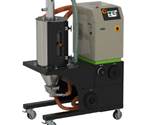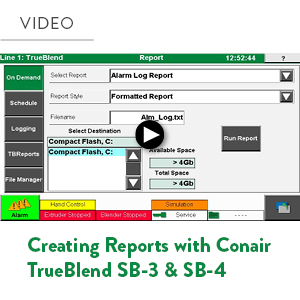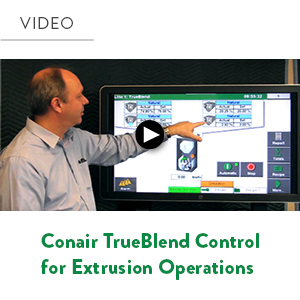How to Blend More Accurately with Gravimetric Blenders
Sponsored ContentWith intelligent and adaptive control technology combined with precision hardware, today’s best gravimetric blenders can deliver previously unachievable levels of accuracy. You’ll see the difference in more consistent injection molded or extruded product and reduced colorant and additive waste.
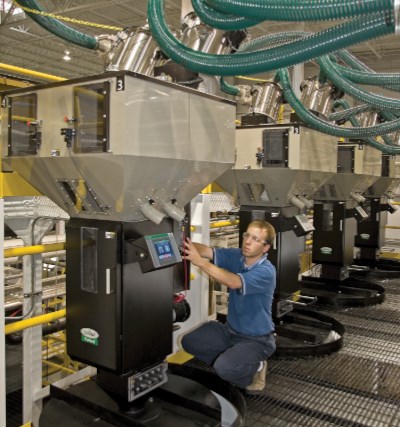
If you think all blenders are pretty much the same, it’s time to look a little closer. For any plastic injection molding, extrusion or compounding process, the accuracy and consistency of the blend is critical to maintaining a stable process with repeatable part quality. The obvious benefit is better end product quality, but there can be big cost advantages as well. For one thing, many plastics processors just live with blending variability by overdosing colorants or other expensive additives on a “just-in-case” basis. And variability in molding or extrusion processes can lead to excess scrap, inconsistent part quality/composition or compromised process speeds. All of it costs you money.
There is technology available, however, that takes the guesswork out of blending with the ability to accurately meter material down to a single pellet. A good example is the TrueBlend Gravimetric Batch Blenders line from Conair, the well known plastics auxiliaries manufacturer. The blenders combine precision electro-mechanical design with an adaptive Smart Blend (SB) control system that can consistently deliver blend accuracy to 0.5% of each material component, even when there are bulk density variations in the materials.

The TrueBlend Blender meters and mixes free-flowing granulate, including regrind and additives. The unit mixes four to twelve materials, depending on model and configuration.
How a TrueBlend Blender Works
For gravimetric blenders that control dosage amount by weighing the material, the accuracy of the load cell is important, but still only part of a system that delivers truly accurate blends, batch after batch. A critical distinction of the TrueBlend design is the sequential way in which it meters out material.
For example, say three materials will be blended — a primary resin, second resin, and an additive. The materials will be added one at a time, with the smallest resin first and the largest last. In this case, the additive is the smallest of the resins, so it is fed first into the weigh bin. This is followed in sequence by the second resin and then the primary resin. When complete, a pneumatic cylinder drops the entire batch into the mixing chamber.
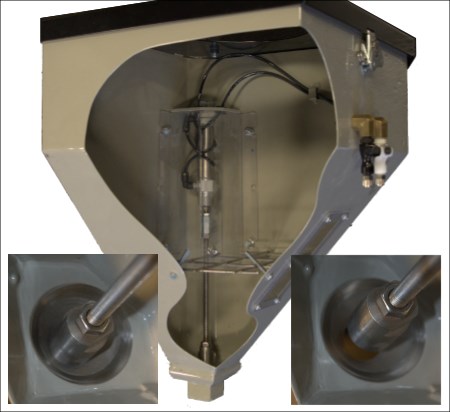
Most blenders use sliding horizontal-style gate valves attached with a clevis pin for dosing. This is a wear part that can reduce dosing accuracy over time. Conair’s unique vertical-style dosing valves eliminate the need for a clevis pin for reduced maintenance and consistent precision, even years later.
TrueBlend Blenders use a precise dispensing system combined with an extremely sensitive load cell to accurately meter out the material. But the proprietary control system takes it a step further by adaptively sizing subsequent material feeds based on the true weight of the first dose of additive. If, for example, the additive is off setpoint by a fraction of a percentage, the control will note the difference and then automatically readjust the setpoint of the subsequent resin dose in order to retain the proper concentration of the second resin and additive relative to one another. The process is then repeated when the primary resin is added.
Besides getting the first batch right, the system automatically adapts to any variability in material forms such as differing size pellets or regrind, which can impact material flow, to keep the blend accurate across a single or multiple process runs. That results in more consistent and higher quality end product and eliminates the need to overdose an expensive additive when blend accuracy is in question.
Continual Process Control
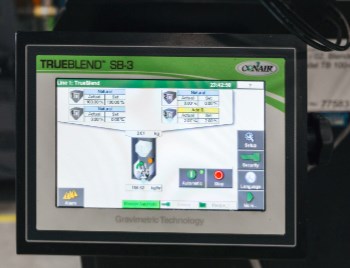
The easy-to-use touchscreen control enables fast setup of blender setpoints and automatically weighs recipe ingredients in a systematic sequence to maintain accurate blend relationships between material components.
There’s much more to maintaining consistency over time with so many material-related factors that can affect an injection molding or extrusion process, and the TrueBlend control and monitoring system can go a long way in helping detect and diagnose those issues. Among the most important is the ability to give operators immediate feedback when problems arise. The control system constantly monitors the feeding and blending process and issues alarm messages for conditions such as:
- Component Valve Failure – Monitors the batch weight for stability at the end of every batch. A leaking valve is detected automatically.
- Material Flow Error – Monitors the flow rates of the component materials to ensure they are consistent.
- Batch Hopper Gate Failure – Monitors the batch hopper weight to ensure it dumps out completely at the end of every batch.
The system can also tell operators about other factors, such as when material is running low, when there are changes in material bulk density, and even when compressed air pressure changes. When deviations from process norms are detected, the control provides explanations and offers suggestions on what to check. It can also be networked for remote monitoring and diagnostics either to in-plant networks or via a secure web conferencing network accessible anywhere in the world.
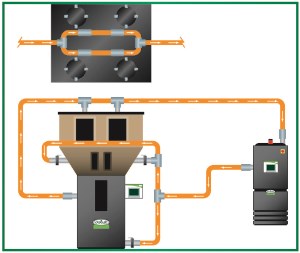
The optional TrueBlend dry air blanket introduces hot, dry air that blankets the material mixing chamber with dry air. The system prevents moisture regain while the material is in the blender.
Another important factor in maintaining process integrity is managing moisture consistency, especially for higher temperature, moisture-sensitive applications. When the material is in a standard temperature range (less than 150°F), the TrueBlend will make a batch, mix it and then hold for the next load of the machine hopper. However, when materials are heated to higher temperatures (up to 375°F), to preserve the heat of the material and to keep moisture out, a new batch will not be made until required to keep the molding machine or extruder fed. Conair also has a dry air blanket option that introduces hot dry air around the material bins and mixing chamber to prevent moisture regain during processing.
Data Collection and Reporting
A great opportunity presented by gravimetric blenders is the ability to gather detailed information about what’s really happening with injection molding and extrusion processes. Because every material component is being measured at the process level, you have definitive data of what materials are being consumed, on which machines and jobs, and when. The question is: How do you collect that data and put it to good use?
This video highlights the reporting functions available in the TrueBlend SB controls.
Conair addresses this opportunity with a number of standard reports that can be generated at the machine level or collected plant-wide. Standard reports cover:
- Current equipment status
- Active and logged alarms
- Shift and total inventory
- Resin usage
- Order and job reports
Reports can be scheduled or produced on demand over a specified time span, and can be displayed locally on the blender control, or shared via thumb drives or an Ethernet connection.
Where this data gathering ability gets really interesting is when it is compiled into a single database, enabling much deeper analysis of plastic processing operations. Conair has facilitated this practice by making all blender control outputs compatible with a standard Microsoft SQL database so that enterprise -wide analysis can be performed to bring greater consistency and efficiency to plant floor operations.
For example, recipes can be recorded and stored centrally, and yield reports can be generated automatically. Resin usage can be analyzed by recipe, shift or in total to help manage inventory. Statistical analysis can be performed for quality assurance purposes. Having so much data in one place unlocks the door to achieving new levels of efficiency and process control that simply were not possible with prior generations of plastics processing technology.
As the TrueBlend line demonstrates, all blenders are indeed not the same, and the difference matters in terms of the level of quality and repeatability you can achieve in injection molding and extrusion processes. With the ability to generate near-perfect blends on every batch, processors can count the benefits in better product, lower scrap rates and lower material costs.
Go here for more information on Conair Gravimetric Batch Blenders.

